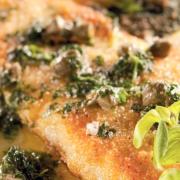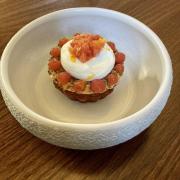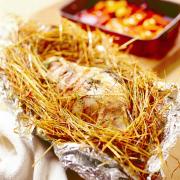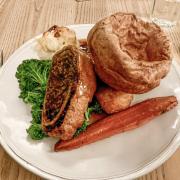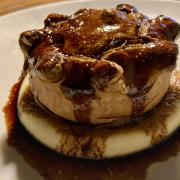A Simnel cake is traditionally eaten at Easter, although it used to be associated with Mothering Sunday: when people were fasting during Lent, Mothering Sunday offered a brief reprise from austerity.
That said, my wife’s birthday this year falls on Mothering Sunday and I think the only way I could guarantee she’d be more annoyed than she is now would be to present her with a fruit cake. Another reason I love them: all the more for me in our household.
The origins of Simnel cake stretch back to medieval times when it was a yeast-leavened bread made from the very best flour – Simila, the whitest and finest available.
By the time the 17th and 18th centuries arrived, the bread had been swapped for a pudding batter and the Simnel cake was like a boiled Spotted Dick filled with dried fruit, spices and almonds.
After cooking, it was wrapped in a pastry coat, glazed with egg and baked until it had a hard crust, a little bit like the Scottish Black Bun which is made at Christmas time.

It wasn’t until the 19th century when Simnel cake began to look like the fruit cake we recognise today and it would take almost another 100 years until the familiar marzipan layers and the rotund, toasted apostle-eggs appeared.
Of course, the marzipan balls represent each of Jesus’ disciples sans Judas, for obvious reasons, and on the most traditional of cakes there will be a blank space where his ball should be (recently, some bakers have added Judas to the Simnel to mark his later remorse and also, presumably, because they wanted more marzipan).
I absolutely love marzipan, it reminds me of those little fruits you’d get in a box at Christmas and which I was taught to make at college: what my strawberries and oranges lacked in artistic flair, they made up for in flavour.
I could eat an entire block of the stuff in a sitting.
And then, to gild the lily at Easter, here’s an easy recipe for Hot Cross Buns, surely one of the best treats at this time of year, sweet and sticky, speckled with dried fruit and mixed peal, fragrant with spices, toasted and served with great butter.
There’s an old belief that if you bake your Hot Cross Buns on Good Friday, they won’t go mouldy during the year that follows, but I have no idea if this is true as they don’t hang around for long enough for me to report back.

Simnel Cake recipe
Ingredients
Almond paste
25g ground almonds
25g caster sugar
25g icing sugar
½ large egg yolk
A little orange juice if necessary
Cake
125g unsalted butter softened, plus extra for greasing
125g caster sugar
2 large eggs, lightly beaten
100g self-raising flour
50g ground almonds
Seeds from 1 cardamon pod crushed
Pinch of ground cinnamon
70g golden raisins or sultanas
70g dried ready to eat apricots, chopped
Finely grated zest an orange
1 tbsp extra flour
Marzipan for top
300g (approximately 200g for the top and 50g for the balls)
1 egg beaten
1 tbsp apricot jam
½ tbsp orange juice
Method:
1. Grease and line the base and sides of a 17cm deep loose bottomed tin with a double layer of baking paper. The paper needs to come about 2.5cm above the sides of the tin.
2. Mix together the ingredients for the almond paste until it comes together as a firm dough adding a little orange juice if necessary. Shape into a block, wrap in cling film and leave to chill until cold and firm. When it is ready to use cut the almond paste into 1cm cubes. Pre-heat the oven to 150°C fan.
3. Put the flours, ground almonds, cinnamon and crushed cardamom in a bowl and combine thoroughly with a dry whisk.
4. In another bowl beat the soft butter until light then gradually add the sugar whilst continuing to beat. Gradually add the beaten egg, if necessary, add some of the flour mix with the final additions of egg to prevent curdling. Toss the dried fruit and diced almond paste in the extra tbsp of flour then gently fold into the batter along with the orange zest. Scrape the mix into the lined cake tin and smooth out the surface. You can leave a dip in the centre so the cake is fairly level when it comes out of the oven.
5. Cover the surface of the cake with a double circle of baking paper with a 2.5cm hole in the centre. Bake in the centre of the oven for approximately 45 minutes until evenly brown, firm to touch and a skewer comes out clean when inserted into the cake.
6. Allow the cake to cool for approximately 15 minutes before turning onto a wire rack, peel off the lining paper and leave upside down to cool completely. The bottom of the cake will give you a nice flat surface to decorate without wasting any of it by having to trim it.
7. Roll out the marzipan until approximately 0.5cm thick and a little larger than the cake. Use the cake tin as a template to cut out a circle. Keep the excess marzipan to shape the balls.
8. Heat the apricot jam with orange juice either in a saucepan or in a small bowl for a few seconds in a microwave. Brush the top of the cake with the warmed apricot jam and firmly cover with the marzipan circle. Mark a criss-cross pattern using a knife (or I use a cake quilting tool for a cushioned effect) and a clean ruler over the marzipan and crimp the edges by pinching with your fingers.
9. Make 11 balls with the rest of the marzipan, damp the bottoms with water and secure around the edge of the cake. Brush the marzipan with beaten egg. Brown the marzipan under a hot grill, do not take your eyes off it as it can burn easily or alternatively, use a blow torch for a more controlled even finish.

Hot Cross Buns recipe
Ingredients
500g strong flour
7g instant yeast
275ml milk
50g butter
1 large egg
75g caster sugar
1.5 teaspoons of salt
Two teaspoons of mixed spice
125g mixed dried fruit
Zest of half a lemon
Two tablespoons of flour mixed with two tablespoons of water
Golden syrup
Method:
1. Warm the milk, add butter to melt and whisk in the egg.
2. Mix the dry ingredients together.
3. Add the liquid and lemon zest and bring to a soft dough, adding a little water if it’s dry.
4. Leave covered in a bowl until doubled in size.
5. Take out and add the fruit, knead on the worktop until all combined and smooth.
6. Divide into 12 equal pieces and mould into small balls. Place on a baking tray either close together or with space between each – it’s up to you.
7. Leave to re-prove (and double in size).
8. Meanwhile, mix the extra flour and water together to make a paste.
9. When doubled in size, score with a sharp knife a cross on top of each bun and then bake at 180C/350F/Gas Mark 4 for 12 to 15 minutes until golden.
10. Warm the golden syrup and brush over the buns to glaze.







